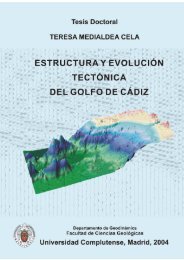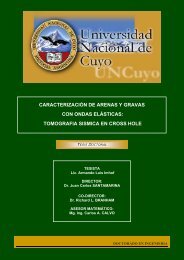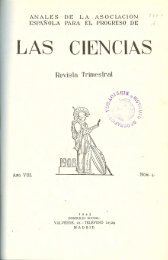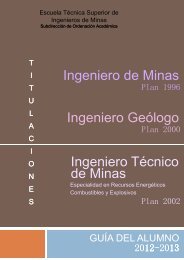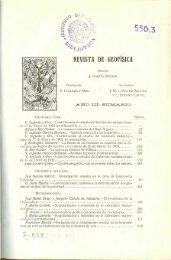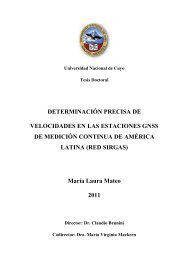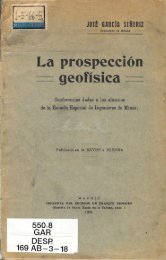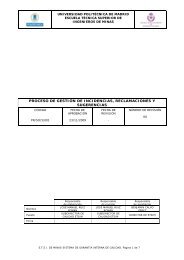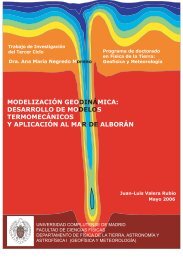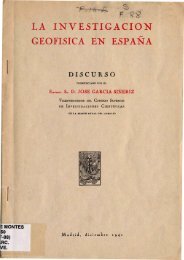estructura gravimétrica y magnética de la corteza del suroeste ...
estructura gravimétrica y magnética de la corteza del suroeste ...
estructura gravimétrica y magnética de la corteza del suroeste ...
You also want an ePaper? Increase the reach of your titles
YUMPU automatically turns print PDFs into web optimized ePapers that Google loves.
Nieves Sánchez Jiménez<br />
En los mo<strong>de</strong>los realizados por ILIHA DSS Group (1993) <strong>la</strong> base <strong>de</strong> <strong>la</strong> <strong>corteza</strong><br />
superior <strong>de</strong>l Macizo Ibérico se sitúa entre 12-14 km <strong>de</strong> profundidad, caracterizándose <strong>la</strong><br />
<strong>corteza</strong> superior por velocida<strong>de</strong>s <strong>de</strong> 6,0-6,1 km/s. En los primeros 3 a 5 km se produce un<br />
rápido aumento <strong>de</strong> <strong>la</strong> velocidad <strong>de</strong>s<strong>de</strong> 3,0 a 5,8 km/s. La <strong>corteza</strong> media presenta valores <strong>de</strong><br />
velocidad <strong>de</strong> 6,3 a 6,5 km/s situándose su límite superior entre los 12-14 km y su límite<br />
inferior entre los 21-23 km. La <strong>corteza</strong> inferior presenta una velocidad promedio <strong>de</strong> 6,8 km/s<br />
y llega hasta los 28-31 km <strong>de</strong> profundidad a <strong>la</strong> que sitúa el límite <strong>corteza</strong>-manto, con una<br />
velocidad <strong>de</strong>l manto superior <strong>de</strong> 8,0 km/s.<br />
González et al. (1993) reinterpretan los perfiles <strong>de</strong> los años 70 y 80 (fig. 3.1) y junto<br />
a los nuevos datos <strong>de</strong>l proyecto ILIHA (fig. 3.4) proponen unos nuevos mo<strong>de</strong>los <strong>de</strong><br />
velocidad <strong>de</strong> ondas P-profundidad para <strong>la</strong> <strong>corteza</strong> en el SO <strong>de</strong> <strong>la</strong> Penínsu<strong>la</strong> Ibérica (fig. 3.5).<br />
44<br />
Profundidad (km)<br />
Velocidad (km/s)<br />
4<br />
0<br />
5 6 7 8 9<br />
5<br />
10<br />
15<br />
20<br />
25<br />
30<br />
35<br />
A<br />
Profundidad (km)<br />
Velocidad (km/s)<br />
4<br />
0<br />
5 6 7 8 9<br />
5<br />
10<br />
15<br />
20<br />
25<br />
30<br />
35<br />
B<br />
Profundidad (km)<br />
Velocidad (km/s)<br />
4<br />
0<br />
5 6 7 8 9<br />
5<br />
10<br />
15<br />
20<br />
25<br />
30<br />
35<br />
C<br />
ILIHA Sur <strong>de</strong> Portugal Golfo <strong>de</strong> Cádiz<br />
Figura 3. 5. Mo<strong>de</strong>los <strong>de</strong> velocidad <strong>de</strong> ondas P para <strong>la</strong>s zonas <strong>de</strong>l Proyecto ILIHA y perfil Trigueros-Santa O<strong>la</strong>l<strong>la</strong><br />
(A), Sur <strong>de</strong> Portugal (B) y Golfo <strong>de</strong> Cádiz (C) propuestos por González et al. (1993).<br />
- En el Golfo <strong>de</strong> Cádiz (fig. 3.5 C) aparece una capa <strong>de</strong> sedimentos que aumenta <strong>de</strong><br />
potencia hacia el sur. La <strong>corteza</strong> se divi<strong>de</strong> en tres capas situadas a profundida<strong>de</strong>s <strong>de</strong><br />
11-18 km y velocidad <strong>de</strong> 6,0 km/s, 18-25 km y velocidad <strong>de</strong> 6,2 km/s y <strong>la</strong> última<br />
entre 25-31 km y una velocidad <strong>de</strong> 7,0 km/s. La velocidad <strong>de</strong>l manto superior,<br />
situado a 31 km <strong>de</strong> profundidad es <strong>de</strong> 8,0 km/s.<br />
- En el sur <strong>de</strong> Portugal (fig. 3.5 B) existe una capa <strong>de</strong> alta velocidad, 6,4 km/s, cerca<br />
<strong>de</strong> <strong>la</strong> superficie, entre 3 y 8 km <strong>de</strong> profundidad. La <strong>corteza</strong> media y superior<br />
presentan varias discontinuida<strong>de</strong>s menores y una transición para el Moho <strong>de</strong> 2 km<br />
que varía <strong>de</strong> profundidad <strong>de</strong>s<strong>de</strong> 31 km en el área <strong>de</strong> Sines hasta 33 km en el Sur, y<br />
con una velocidad <strong>de</strong> 8,0 km/s.<br />
- Para el bor<strong>de</strong> sur <strong>de</strong>l Macizo Ibérico, es <strong>de</strong>cir, <strong>la</strong> zona cubierta por los perfiles <strong>de</strong>l<br />
proyecto ILIHA, D1 y D2, y el perfil Trigueros-Sta. O<strong>la</strong>l<strong>la</strong> (fig. 3.5 A), <strong>la</strong> <strong>corteza</strong> se<br />
divi<strong>de</strong> en tres capas con velocida<strong>de</strong>s que aumentan progresivamente <strong>de</strong>s<strong>de</strong> 4,3 km/s<br />
hasta 8,0 km/s en el manto superior. La velocidad <strong>de</strong> <strong>la</strong>s ondas P es <strong>de</strong> 6,0-6,1 km/s<br />
entre los 5 y 15 km don<strong>de</strong> cambia a 6,2 km/s y a 6,6 km/s a una profundidad <strong>de</strong> 21<br />
km aumentando progresivamente hasta alcanzar una velocidad <strong>de</strong> 7,4 km/s en el<br />
límite <strong>corteza</strong>-manto.



